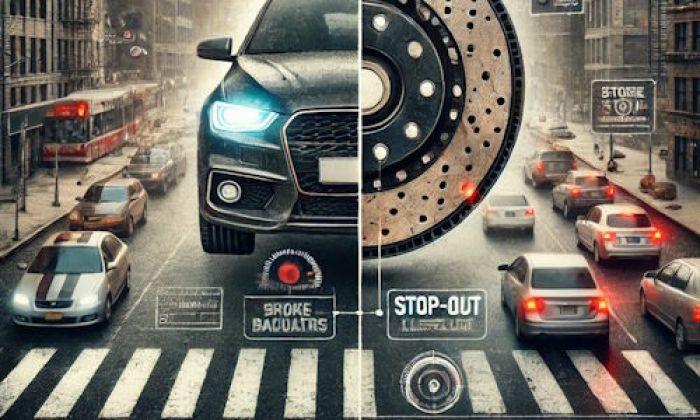If your Ford says "High Engine Temperature, Stop Safely", immediately do what the car asks you to do. You need to stop your car as soon as possible and turn off your engine. Don't try to figure out what's happening - your first task is to turn off the engine to avoid serious problems and damage from overheating.
High engine temperature message highlights
- Common reasons:engine actually overheating, temperature sensor dead
- How to fix:stop the vehicle, let it cool down, check the coolant level, check the temp sensor
- Possible consequences:engine may quickly die
- Priority level:High
- Can you drive?Not recommended
- DIY repair:Possible
- Repair price range:$50-$550
.jpg)
What should you do when you see the temperature warning?
So, you already know that driving with this warning on the dash is extremely dangerous for your engine. Just drive several miles further and get warped rod bearings, cracked crankshaft, destroyed cylinders, and stuck valves. Overheating is not the best friend of your engine in any case.
Of course, the first thing you should do when you see the message is to quickly find a safe place and park your car, then shut off the engine.
Here's what should happen:
- once you notice the warning message, turn on the blinker and move to the right side of the road (or to the left if you are in Britain);
- shut off the engine and turn on the emergency alarm lights if you are not parked in a safe and legal place;
- if you need to move your car further, do this by pushing it with the help of some other people, don't start the engine;
- turn on the ignition and look at the temperature gauge - the needle should be at about half of the gauge, anything higher is dangerous;
- open the hood to let the engine cool down faster, look at the coolant reservoir (but don't open the cap please!) and make sure the coolant is OK;
- look for any leaks under the hood and if there are any, try to locate their source.
If you see that the coolant is low, there are leaks, the engine releases some smoke, or something else weird happening under the hood of your car, you will probably want to call a tow truck because starting your engine is not a very good idea, under these conditions.
If everything looks pretty good, you will want to wait for 10-15 minutes to let the engine cool down before doing anything else with your car.
What are the common reasons for this message?
So, the "High Engine Temperature, Stop Safely" message is thrown by the ECU. The scenario is triggered by the engine coolant temperature sensor. Once it reaches a critically high temperature, it sends the code to the ECU and you see this warning demanding to stop the car.
The problem is that Ford will only show this message when the situation is critical. That's why it's a pretty good habit to regularly glance at the temperature gauge and make sure everything is OK. The message will pop up when the temperature of the engine is way higher than normal. And this is why stopping right away is extremely important.
Here's what can be the reason for engine overheating in your Ford:
1) Temperature sensor
Well, the sensor doesn't cause overheating but it can go bad and eventually send bad readings. Your engine will be completely fine but the sensor will glitch and sometimes send high-temperature codes to the ECU. If this is the case, you will see the temperature dropping unnaturally high once you turn off the engine and then turn on the ignition.
Replacing the temperature sensor in Ford cars is not a DIY job. If you don't have any technical skills and experience, I strongly recommend finding a good mechanic for this job. It shouldn't be too expensive, anyway.
2) Thermostat issues
Thermostat problems are very common for some Ford engines, including the Focus 2.0 engine and almost all EcoBoost models. The thermostat may get stuck open or closed. If it's stuck open, you will see low temperatures at all times. If it's stuck close, the engine will heat up immediately and overheat for several minutes of driving.
Also, the radiator fan won't be activated as the hot coolant doesn't reach the radiator. The coolant circulates the small circle inside the engine and heats up as crazy. The radiator is cold but the temperature sensor sends mad readings which you observe on your dash.
The thermostat should be replaced. Again, this is quite a tricky process and I don't recommend doing it on your own unless you know what to do.
3) Radiator fan
If the fan is the culprit, it's easier to locate. The overheating will not be as quick as with the thermostat stuck closed. Everything will work fine till you get to the traffic jam and have to idle for a long time. Or maybe you wait for your spouse to come out of the supermarket and decide to idle the engine for AC or heater work.
If this is the case with your Ford, the radiator fan is your number one thing to check. Also, you may want to check the radiator fan fuse and other electrical units that control it. These problems are common for the Focus, Ecosport, and Fiesta. But they may also affect other Ford models.
4) Low coolant
This is easy. Low coolant levels will interfere with coolant circulation and will eventually lead to overheating. Check the level and add coolant if needed. Also, you will need to locate the leak. If there is no external leak but the coolant still disappears, check if your Ford emits some white smoke when driving and idling. If this happens, maybe the culprit is the broken head gasket or cracked engine.
The coolant may get into the combustion chamber and burn there forming the white smoke. But external leaks are much more common, so start with checking for these leaks.
If you are in the middle of nowhere and you have no coolant, you may add clean water to the reservoir. Once you are in some city, plan your visit to a good repair shop or dealership and change the coolant in the engine cooling system.
What can you do on your own to solve the issue?
There are a couple of DIY things that can save the situation:
- check everything and control the symptoms - this will help you inspect the car for free and understand what the problem is;
- check the coolant level and add it if needed, just don't open the cap till the engine cools down;
- check for any leaks or other visible problems under the hood;
- check the radiator fan - if it's not activated when the car overheats, this may mean the fan is dead, you may check the electrical units and the fan itself;
- once the engine cools down properly, observe the way it heats up and register all the strange patterns in its behavior.
While an average car owner won't be able to replace a thermostat or cope with a coolant leak, they will be able to locate and replace the bad fuse or relay. Even replacing the radiator fan is pretty easy in Ford vehicles. So, if you want to solve the problem on your own, just inspect the vehicle using everything you know after reading this article.
Can you drive with the overheating warning on the dash?
Well, driving with a very hot engine is just killing your car. But there is a way to drive without putting your engine at risk of dying.
Here's what you need to do:
- stop immediately whenever you see this error message on the dash of your Ford;
- turn off the engine, open the hood to let it cool down faster;
- start the engine after 10-15 minutes and make sure that the temperature gauge shows normal readings (up to half of the gauge);
- you may safely drive until the needly goes higher than half of the gauge;
- after the needle goes higher than that, don't wait for the warning to pop up, stop the vehicle and let it cool down again.
By doing this, you will avoid calling a tow truck and will be able to drive to your primary destination or to the repair shop. If you drive with the engine temperature gauge showing crazily high readings, chances are your engine will meet its demise before you come to your destination.
Final thoughts
Although modern engines are pretty smart and can withstand some hard conditions, they require your understanding of how to react to different possible problems. If you see the temperature of the engine rising, you should stop the car. Without this, your engine may die within several minutes of driving hot.
I hope this article is helpful for you. If you have some information to share or want to ask a question, please write in the comments below!
About the authors
The CarAraC research team is composed of seasoned auto mechanics and automotive industry professionals, including individuals with advanced degrees and certifications in their field. Our team members boast prestigious credentials, reflecting their extensive knowledge and skills. These qualifications include: IMI: Institute of the Motor Industry, ASE-Certified Master Automobile Technicians; Coventry University, Graduate of MA in Automotive Journalism; Politecnico di Torino, Italy, MS Automotive Engineering; Ss. Cyril and Methodius University in Skopje, Mechanical University in Skopje; TOC Automotive College; DHA Suffa University, Department of Mechanical Engineering






Add comment